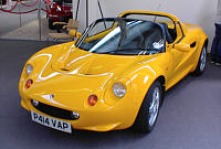Lotus Elise

The Lotus Elise is a roadster conceived in early 1994 and released in September 1996 by the English manufacturer Lotus Cars. The car has a hand-finished fibreglass body shell atop its aluminium extrusion and bonded frame that provides a rigid platform for the suspension, while keeping weight and production costs to a minimum. The roadster is capable of speeds up to 240 km/h (150 mph). The Elise was named after "Elisa", the granddaughter of Romano Artioli who was chairman of Lotus at the time of the car's launch.
The design philosophy of Lotus is "Performance through light weight", first adopted by the founder of Lotus, Colin Chapman. The motto drives Lotus to obtain performance with lightweight cars instead of high power outputs, emphasizing driving purity and dynamics. The result is a sports car that in production form in 1996 weighed in at just 720 kg (1,587 lb). For comparison, a Porsche Boxster is 74% heavier at 1,250 kg (2,756 lb).
The Series 1 Elise is able to accelerate 0-60 mph in 5.8 seconds despite its relatively low power output of 118 bhp (88 kW/120 PS). Braking, cornering, and fuel consumption are also improved by the car's reduced weight.
Heading the design and engineering teams that created Series 1 were Julian Thomson, then head of design at Lotus, and Richard Rackham, Lotus's chief engineer.
Although high-tech, it represented affordable cost of ownership for people who love sports cars on a budget who still wanted performance and looks.
Besides the "standard" higher-performance variants listed below, Lotus also released some limited edition models such as Sport 135 (1998/9) with approx 145 bhp (108 kW), Sport 160 (2000) with 150–160 bhp (112–119 kW) and Sport 190 (190 bhp / 142 kW). These were more competent on track with sports suspension, wheels and tyres, seats according to model. There were other special editions which were basically cosmetic treatments such as the 50th Anniversary Edition (green/gold) celebrating 50 years of Lotus cars, the Type 49 ("Gold Leaf" red and white two-tone), and Type 72 ("JPS" black/gold) to recall their successful Grand Prix car type numbers.
Information from
Related pages: Cars, Lotus Europa
